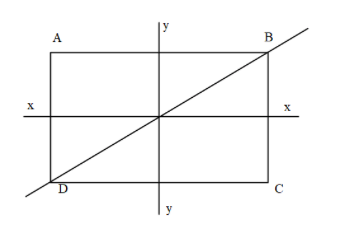
In a rectangle$ABCD$ ,$AB = 2l$ and$BC = l$. Axes $xx$ and $yy$ pass through the centre of the rectangle. The moment of inertia is least about:

A) $BD$
B) $BC$
C) $xx$
D) $yy$

Answer
557.4k+ views
Hint:The moment of inertia depends upon the mass of the body and the square of the distance from the axis of the particles of the body, so we need to find the axis from which the distance of the particle will be least.
Complete Step by step solution:
It is given in the problem that in a rectangle$ABCD$ ,$AB = 2l$ and$BC = l$. Axes $xx$ and $yy$ pass through the centre of the rectangle and we need to find the axis at which the moment of inertia is minimum.
Here we can observe that the axis from which all the particles are at minimum distance is the axis xx.
The correct answer for this problem is option C.
Additional information:The parallel axis theorem is used to calculate the moment of inertia about an axis which is parallel about a given moment of inertia. $I = {I_c} + M{h^2}$,here$I$ is the moment of inertia about an axis which is parallel to ${I_c}$ and which is $h$ distance away from it. The moment of inertia can be defined as the ratio of torque to the angular acceleration. The moment of inertia is equal to the product of mass and square of radius of gyration, the radius of gyration is the distance from the axis of rotation to the point at which the body would have the same moment of gyration.
Note:It is advised to students to understand and remember the formula of the moment of inertia and also it is important for students to remember the moment of inertia of some standard bodies. The moment of inertia is defined as the ratio of the angular momentum and angular velocity.
Complete Step by step solution:
It is given in the problem that in a rectangle$ABCD$ ,$AB = 2l$ and$BC = l$. Axes $xx$ and $yy$ pass through the centre of the rectangle and we need to find the axis at which the moment of inertia is minimum.
Here we can observe that the axis from which all the particles are at minimum distance is the axis xx.
The correct answer for this problem is option C.
Additional information:The parallel axis theorem is used to calculate the moment of inertia about an axis which is parallel about a given moment of inertia. $I = {I_c} + M{h^2}$,here$I$ is the moment of inertia about an axis which is parallel to ${I_c}$ and which is $h$ distance away from it. The moment of inertia can be defined as the ratio of torque to the angular acceleration. The moment of inertia is equal to the product of mass and square of radius of gyration, the radius of gyration is the distance from the axis of rotation to the point at which the body would have the same moment of gyration.
Note:It is advised to students to understand and remember the formula of the moment of inertia and also it is important for students to remember the moment of inertia of some standard bodies. The moment of inertia is defined as the ratio of the angular momentum and angular velocity.
Recently Updated Pages
Master Class 11 Economics: Engaging Questions & Answers for Success

Master Class 11 English: Engaging Questions & Answers for Success

Master Class 11 Social Science: Engaging Questions & Answers for Success

Master Class 11 Biology: Engaging Questions & Answers for Success

Class 11 Question and Answer - Your Ultimate Solutions Guide

Master Class 11 Business Studies: Engaging Questions & Answers for Success

Trending doubts
What is meant by exothermic and endothermic reactions class 11 chemistry CBSE

10 examples of friction in our daily life

One Metric ton is equal to kg A 10000 B 1000 C 100 class 11 physics CBSE

Difference Between Prokaryotic Cells and Eukaryotic Cells

What are Quantum numbers Explain the quantum number class 11 chemistry CBSE

1 Quintal is equal to a 110 kg b 10 kg c 100kg d 1000 class 11 physics CBSE




